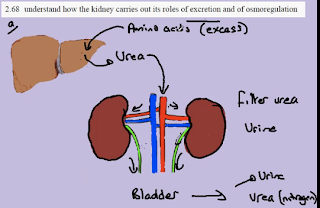describe the process of evolution by means of natural selection.
-evolution: change in the form of organisms. (new form of organisms arising)
: change in frequency (how many) of alleles.
-natural selection: the mechanism of evolution (first proposed by Charles Darwin)
-SA (Staphlococcus aureus) causes skin infection and also lung infection
evolving SA
first graph
-normal form is susceptible to methicillin (antibiotic) (antibiotic can kill SA)
-MSSA (methicillin susceptible SA)
second graph
-random mutation in SA allow breaking down of methicillin.
-because it can break down it can no longer killed by the antibiotic (resistant form)
-MSRA (red on graph)
-2 forms of bacteria (called evolution) [MSSA, MSRA]
-when antibiotic are applied to the population MSSA is decreased and MRSA is becoming increasing common
-evolution: increase in frequency of allele (or resistance)
2 features
-random mutation produces MRSA form
-the non random selection (due to antibiotics) selects MRSA to survive and MSSA to be selected and killed.
-natural selection is a process not a list.

























